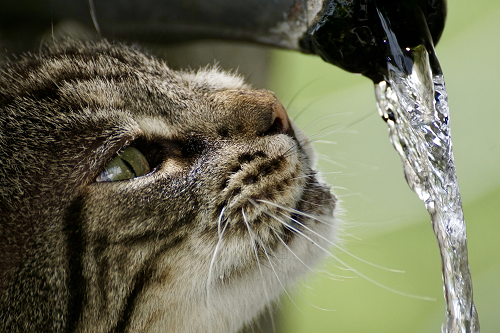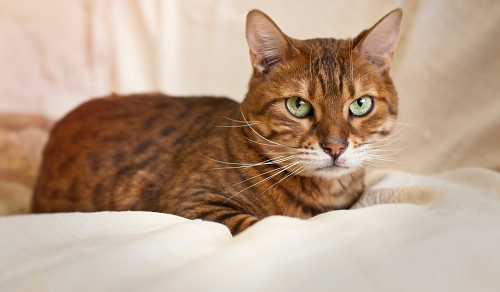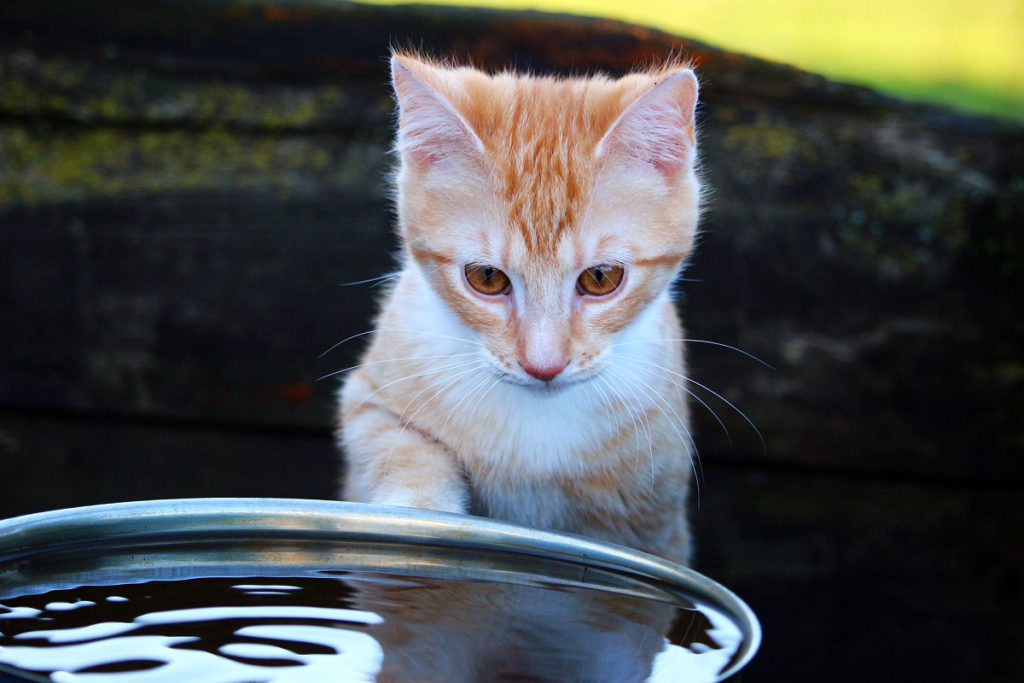With the abundance of viral pet memes and videos, it has become all too common to see footage of feline friends appearing to utterly despise water. Whether being disciplined with a squirt bottle, forced to take an unwanted bath, or falling into a shallow pool, cats are typically seen running, jumping, or entirely spazzing out when it comes to any water contact at all
At the same time, however, there is a fair share of videos showing cats appearing to be curious and even mystified in the presence of water. Whether it’s a hose, faucet, waterfall, or shower, cats seem to exhibit a fascination for moving water. Video footage typically captures cats inquisitively staring, pawing, or even drinking from a stream of water. In this case, the cat is the active spectator, and perhaps most importantly, in full control.
So, while cats generally appear to hate water, this certainly does not apply to all circumstances or even all cat breeds. The complexities of this love-hate relationship cannot be explained by one simple theory. Rather, the evolution of key biological and behavioral traits of the cat explain our feline’s friend ambiguity to water.
This article will answer the question “Why do cats hate water?” and provide a deeper insight into this odd behavior.
Why Do Cat’s Not Like Water?
Theory 1: Born to be Wild – In the Desert
One theory suggests that the domesticated cat descended from the Arabian wild cat, known to reign in the infamously arid deserts of the Middle East. It is surprising to think of cats
as desert dwellers! Dating back to their early origins, wild cats were domesticated by nearby farmers as that they could be used as vermin hunters. With all their hunting and living needs satisfied, early domesticated cats grew fond of this new luxury where humans made sure all their needs were met – food, safety, and independence.
Throughout the Middle East, where water was a precious commodity, the first domesticated cats had utterly nonexistent exposure to rivers, lakes, streams, or oceans. As such, cats never encountered a situation that necessitated total water immersion. Thus, cats had no need, pressure, or evolutionary advantage for learning how to swim.
Theory 2: Who Likes Change?
In comparison to the domesticated dog, cats are considerably less tolerant to change. Ultimately, this boils down to a critical behavioral difference between cats and dogs: environmental attachment. Whether it’s moving to a new house or introducing bath time into a routine, environmental changes are internalized as high-stress moments for cats. For this reason, it is important for cat owners to take additional measures when transitions are necessary. Further, cats are generally more grooming-obsessed compared to dogs. While most dogs actually enjoy rolling around in dirt or mud, this would probably be a cat’s worst nightmare. Cats not only avoid getting dirty, they go to great lengths to ensure their fur coat is always in tip-top shape. So, while a tap water bath is considerably cleaner than a mud bath, it is still filled with chemicals which cats may be able to smell.
Theory 3: Eww, that Smells Bad!
Attributed to early hunting and social communication, cats are highly sensitive to smell. In fact, cats have twice as many receptors for scent as their human owners. While humans just smell through their nose, cats have additional scent glands on their lips, chin, head, tail, paws, and anus. And although we may not smell a difference between tap water and purified water, we do know that they are chemically very different. According to theorists, cats may be grossly turned off by the scent of tap water chemicals mixing with the hygienic, good-smelling chemicals from their own skin and well-maintained fur coat.
scent as their human owners. While humans just smell through their nose, cats have additional scent glands on their lips, chin, head, tail, paws, and anus. And although we may not smell a difference between tap water and purified water, we do know that they are chemically very different. According to theorists, cats may be grossly turned off by the scent of tap water chemicals mixing with the hygienic, good-smelling chemicals from their own skin and well-maintained fur coat.
Theory 4: Look Good, Feel Good
Due to regular licking, a cat’s fur typically lacks natural oils. To a cat, this makes them not only smell pleasant, but also feel more lightweight and agile. Conversely, when cats get wet, their oil-free fur readily soaks up the water. This makes their coat feel heavier, and a saturated coat quickly leads to a cat feeling cold. An additional problem is that now the cat has lost control of their temperature regulation. They cannot as easily regulate how quickly their fur coat will dry and when they will feel less cold. Additionally, this sopping wet coat likely makes a cat feel less maneuverable and fast. Overall, a wet cat feels emotionally powerless and physically uncomfortable. The only way to alleviate the situation is in an attempt to lick their entire coat dry.
So, while occasional or as-needed bathing may make your cat smell better to you, your cat probably sees it quite differently. This can range from being an inconvenience necessitating hours of additional grooming to inciting a panic since they can no longer move freely. Disorientation due to a drastic change in their grooming routine, odor balance, and sense of control is also unwelcome.
Exceptions to the Rule
It’s difficult to make overarching statements that include all members of an entire species. There are always exceptions to the rule!
- Type: While most cats don’t enjoy being fully soaked with water, some do seem to enjoy watching or drinking from small, steady flows of running water. Why? This relates to a cat’s primal instinct that an active flow of water is generally fresher in the wild. Natural water sources that are moving also have less risk of contamination, compared to still muddy pools.
- Breeds: The Bengal, Maine Coon, and Abyssinian are not opposed to occasional swimming. The Turkish Van’s waterproof coat and webbed paws speak volumes.
A Closer Look at One Exception
The Bengal cat’s fascination with water can be related to the behavior of their ancestors, the Asian Leopard. These hunters were known to be curious and fearless. They also had the habit of cleaning their paws in water before using them to drink from a river or stream. This behavior can be traced back to its ancestors, the Asian Leopard Cat. In nature, wild cats usually use their paws to remove any dirt from the water surface of a river before drinking.
The Maine Coon is thought to be a descendant of the Turkish Angora or the Norwegian Forest Cat. The Turkish Angora, like the Turkish Van below, evolved around Lake Van. The Norwegian Forest Cat was a companion of Vikings, and commonly accompanied them on long ocean voyages.
 While there is not as much information available to explain why the Abyssinian cat enjoys water, it is known that they originally came from Ethiopia. British soldiers bought wild Abyssinian kittens as part of trade exchange and domesticated them for use as a ship worker and personal companion. Like the Maine Coon, the first domesticated Abyssinians lived on ships and had an important role in keeping them free of pesky critters.
While there is not as much information available to explain why the Abyssinian cat enjoys water, it is known that they originally came from Ethiopia. British soldiers bought wild Abyssinian kittens as part of trade exchange and domesticated them for use as a ship worker and personal companion. Like the Maine Coon, the first domesticated Abyssinians lived on ships and had an important role in keeping them free of pesky critters.
Nicknamed the “Swimming Cat”, the Turkish Van originated from Turkey’s Lake Van Region, where temperatures can reach 115°F in the summer. Due to the close proximity of a sizeable lake combined with scorching hot temperatures, it was important for the Turkish Van to evolve physical characteristics to help them cope with frequent water immersion, such as a waterproof coat and webbed paws.
Regular swimming not only worked to prevent overheating, but helped them to survive against the sun and hunt for food. As with most desert regions, scorching hot temperatures during the day can be followed by frigid temperatures at night. In order to internally self-regulate and externally cope with both extremes – overheating and frostbite – the Turkish Van’s waterproof coat ultimately functioned as a fully insulated, built-in wetsuit, allowing them to swim during the day without freezing during the night.
Tools to Help with Bath Time
- Cat shampoo: Although a pet shampoo designed especially for cats is preferable, a mild soap cleanser can also work. Just be sure to search online whether it can be used on animals.
- Faucet hose: Be sure to measure the length of the hose in advance to ensure it stretches from your sink to your tub.
- Pitcher: If you don’t have a pitcher available, a bucket can work too. A pitcher is simply more convenient due to its handle and narrow spout. These two components give you more control over water delivery.
- Treats: Having treats on hand may help your cat cooperate.
- Towels: One towel is for drying, and the others are for clean-up. No one said bathing a cat would be an easy, clean, or dry experience!
- Vinyl gloves: These are really for your own protection. In the event of retaliation or scratching, vinyl gloves should protect your hands. For added protection, consider wearing a long sleeve shirt.
Helping Your Cat to Not “Hate” Bath Time
The most prevalent, and perhaps obvious suggestion is to introduce bathing as early as possible. This way the cat can become more accustomed to all the properties of water, such as how it looks, smells, feels, and tastes. Most importantly, you need to help your cat cope with the feeling of a post-bath, water-soaked fur coat. Although you won’t need to bathe your self-grooming cat often, it is important to do so at least a few times a year. While cats can self-groom, they cannot necessarily self-cleanse. In other words, they can lick away the natural oils that would otherwise matte their fur, but they cannot easily remove a bad smell. This is where a bath comes in handy, and hopefully, your cat will learn how to be a cooperative participant.
Here are a few different approaches you can try at bath time:
- Method 1: Start by placing your cat in an empty tub or sink and soak a washcloth with room-temperature water by soaking it in a nearby bucket. Gently glide the washcloth over the fur. In this method, your cat will never be exposed to a stream of water. Generally speaking, this is a good place to begin.

- Method 2: Start by placing your cat in an empty tub or sink, and slowly adjust the water from low to high. Starting with a trickle, continue to increase the water flow until the bath is adequately filled. When steadily increasing the flow of water, take a few minutes between each adjustment until your cat adjusts. It’s important, however, to be patient with this process. It’s better to play it safe and not scare your cat out of the tub, even if it means taking a considerably longer amount of time to fill the bath.
- Method 3: Start by placing your cat in an empty tub or sink with a small trickle of water already flowing. Consider putting your cat in the room and giving him time to gravitate toward the flowing water. If this natural curiosity does not result, consider incentivizing your cat to move closer with a strategically-placed treat. If this still does not get your cat into the tub or sink, physically move your cat. Allow the flowing water to fill a pitcher and pour evenly over your cat.
- Method 4: A final method involves putting your cat in an empty tub. Use a hose to transfer water from the sink to the tub. Using this hose method, the cat may feel more comfortable with the owner physically holding and controlling the flow of water.
Once you pick a suitable water soaking method, use a dime-size amount of feline-friendly shampoo and gently lather into the skin. Start from the head to tail and make sure to be careful around the face, so as to avoid the inside of the eyes, ears, nose, and mouth. Although your cat will likely be more than ready to get out of the tub after the first rinse, aim to be thorough, not quick. Leftover shampoo residue can cause feline skin irritation as well as an icky taste when your cat is licking its fur dry. And we don’t want to mistakenly give the cat a reason to despise bath time, when the end goal is just the opposite! Last, but not least, gently pat dry with a clean, soft towel.
Whether you start the bath from a sink or a tub, empty or full, using a spout, hose or pitcher, be willing and able to adjust your strategy. If you’re at a loss, consider asking your veterinarian for their professional opinion or simply try a combination of methods and see which approach is the least aversive. And if all else fails, take your cat to a groomer and cross this chore off your list!
Final Remarks
If your cat seems shy or scared by water, remember to keep in mind that praise really goes a long way. Even if it’s not the extreme of a fully immersive bath, encourage daily interactions with water. This will only help condition the cat to see water both as rewarding and non-threatening. Whether you opt for encouraging words, physical hinting, treat-based conditioning, or a combination of the three, consistent praise is always a useful tactic when introducing a new element to his routine. The daily consensus may be that cats hate water, this assertion is simply too broad, as it does not apply to all breeds, situations, and environments. With careful planning and an understanding of your cat’s point of view, your feline friend can learn to coexist with water.
Sources
“3 Reasons Why Cats Hate Water (And Why Some Like It!).” Pets Best, Accessed 10 Jun. 2019.
https://www.petsbest.com/blog/3-reasons-cats-hate-water-like/.
“3 Strange Things Your Bengal Cat Does And Why.” Blind Bengal, Accessed 17 Jun. 2019. https://blindbengal.com/3-strange-things-bengal-cat/#tab-con-4.
“Abyssinian.” Point Vicente Animal Hospital, Accessed 17 Jun. 2019. https://www.pointvicentevet.com/services/cats/breeds/abyssinian.
“A Cat is Highly Sensitive to Scent.” Redmond Veterinary Clinic, Accessed 10 Jun. 2019. http://www.redmondvetclinic.com/small-animal-care/cats/miscellaneous-feline/A_Cat_is_Highly_Sensitive_to_Scent.
“Do All Maine Coon Cats Like Water?” Maine Coon Expert, Accessed 17 Jun. 2019. https://mainecoonexpert.com/do-all-maine-coon-cats-like-water/.
“Do Cats Really Hate Water?” Discovery Communications, Accessed 10 Jun. 2019. http://www.animalplanet.com/pets/healthy-pets/do-cats-really-hate-water/.
“Turkey’s Weather and Climate Regions.” Turkey Travel Planner, Accessed 10 Jun. 2019. https://turkeytravelplanner.com/WhenToGo/ClimaticRegions.html.
“Why Do Cats Hate Water?” Hill’s Pet, Accessed 10 Jun. 2019.
https://www.hillspet.com/cat-care/behavior-appearance/why-do-cats-hate-water.
“Why Do Cats Hate Water?” Mother Nature Network, Accessed 10 Jun. 2019. https://www.mnn.com/family/pets/stories/why-do-cats-hate-water.
“Why Do Cats Hate Water?” Science Focus, Accessed 10 Jun. 2019. https://www.sciencefocus.com/nature/why-do-cats-hate-water/




